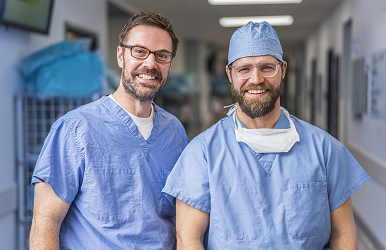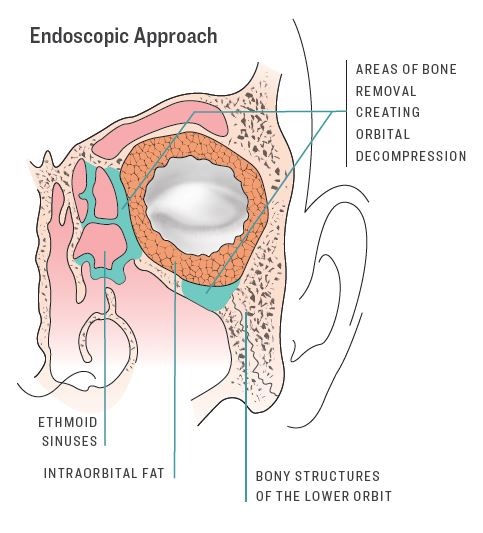
A collaborative program designed to treat thyroid eye disease (TED) at the University of Utah offers patients access to highly customized treatments—including a delicate endoscopic surgery at the John A. Moran Eye Center now available in the Mountain West.
The thyroid, a small, butterfly-shaped gland at the base of the neck, just below the Adam’s apple, manufactures the hormones that regulate the body’s metabolism. For the most part, this essential organ does its amazing job and goes unnoticed. But for millions of people in the U.S., a range of thyroid disorders can create life-changing conditions—including TED.
Graves’ Orbitopathy: Symptoms, Diagnosis, and Treatment
One of the most common consequences of TED is an eye socket disorder in adults, seen mostly in patients with hyperthyroidism. Often referred to as Graves’ disease, this autoimmune disorder generally causes thyroid overactivity.
"About half of patients with Graves’ will develop an eye disease known as Graves’ orbitopathy, and some of this group will require surgery," according to Douglas Marx, MD, Moran’s oculoplastic division director and co-founder of the university’s TED program, known as UTED. "However, Graves’ disease is not the only cause of orbitopathy, so diagnoses and treatments can be complex. I’ve seen it in patients with low thyroid and, in a handful of cases, non-thyroid issues."
When Graves’ disease affects the eyes, the fat and muscles around them may enlarge. This inflammation causes the eyes to bulge, preventing the eyelids from closing completely. In turn, patients can experience extreme dryness or tearing and scrapes on the surface of the eye that may lead to infection. Also, because the eye socket stays the same, the enlarged eye muscles may not move properly, and this can cause double vision. Increased pressure in the eye socket can also damage the optic nerve, causing loss of eyesight.
An innovative surgery called endonasal endoscopic orbital decompression—offered at Moran—is often the solution to relieve the pressure, all done through the nose without external incisions through the skin.

Innovative Surgery Option for Treating Graves' Orbitopathy
With advances in surgical instruments and techniques, the minimally invasive endonasal endoscopic orbital decompression procedure has become a safe and effective option, according to Jeremiah A. Alt, MD, PhD, FACS, a sinus and skull base surgeon and co-founder of the UTED program.
"Dr. Marx and I work in tandem to perform these endoscopic orbital and optic nerve decompressions operating within the eye socket, through the sinuses," he said.
For more complex cases, the two surgeons use a four-handed technique. This allows them to operate simultaneously, with the primary surgeon using both hands for the delicate removal of bone.
We’re excited to be able to offer exceptional facilities and an unprecedented team approach to thyroid eye disease and Graves’ orbitopathy, as well as a host of other endoscopic procedures to patients who can benefit immensely from having this expertise right here at the Moran Eye Center.
Douglas Marx, MD, and Jeremiah A. Alt, MD, PhD, FACS, co-directors of UTED
"In addition to the skill involved in just getting to the bone safely, the trick is knowing exactly how much bone to remove. Sometimes it’s just a millimeter," Marx said. "Each case is completely customized. When the surgery is complete, the eye muscles have room to fit back in the socket."
While the surgery isn’t without risks, it offers life-changing relief to patients.
"Ultimately, the endoscopic approach to the eye or orbit is safe, can be done without external scars, and is currently the least invasive corrective option available," said Alt.
The university’s TED team includes fellowship-trained physicians in endocrinology, sinus and skull base surgery (endoscopic experts), oculoplastics, and neuro-ophthalmology. That’s because many TED patients need a team with both medical and surgical expertise.
The endocrinology team plays a pivotal role in evaluating and managing medication, helping patients get their thyroid disease under control, and then potentially starting medications that can reduce inflammation and improve vision changes associated with the condition.
"Our team approach is key to providing patients with the best possible outcomes for a condition that is often difficult to diagnose," said Marx.